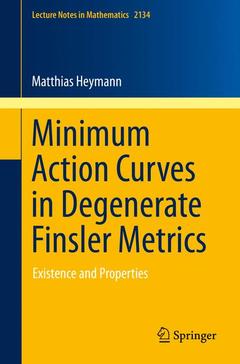Description
Minimum Action Curves in Degenerate Finsler Metrics, 1st ed. 2015
Existence and Properties
Lecture Notes in Mathematics Series, Vol. 2134
Author: Heymann Matthias
Language: English
Subjects for Minimum Action Curves in Degenerate Finsler Metrics:
186 p. · 15.5x23.5 cm · Paperback
Description
/li>Contents
/li>Comment
/li>
Presenting a study of geometric action functionals (i.e., non-negative functionals on the space of unparameterized oriented rectifiable curves), this monograph focuses on the subclass of those functionals whose local action is a degenerate type of Finsler metric that may vanish in certain directions, allowing for curves with positive Euclidean length but with zero action. For such functionals, criteria are developed under which there exists a minimum action curve leading from one given set to another. Then the properties of this curve are studied, and the non-existence of minimizers is established in some settings.
Applied to a geometric reformulation of the quasipotential of Wentzell-Freidlin theory (a subfield of large deviation theory), these results can yield the existence and properties of maximum likelihood transition curves between two metastable states in a stochastic process with small noise.
The book assumes only standard knowledge in graduate-level analysis; all higher-level mathematical concepts are introduced along the way.
Preface.- Acknowledgements.- Acronyms.- Part I: Results.- Introduction.- Geometric Action Functionals.- Existence of Minimum Action Curves.- Properties of Minimum Action Curves.- Conclusions.- Some Proofs and Remarks.- Part II: Proofs.- Finding Points with Local Minimizers.- Proof of Lemma 6.1.- Part III: Proof of a Technical Lemma.- Proof of Lemma 6.15: Main Arguments.- Proof of Lemma 6.15: Some Technical Details.- Glossary.- Index.- References.
Explores the non-standard geometric view of the Wentzell-Freidlin theory of rare transition events
The general geometric framework may spawn applications outside of probability theory
Key results and their explanations are well-separated from the necessary technical proofs, making it easy to quickly use the proven existence criteria in practice
Includes many intuitive examples with color illustrations
Only a knowledge of graduate level analysis is required; all non-standard concepts are introduced as needed
Provides detailed complete proofs that do not require any additional work by the reader to fill the gaps
Includes supplementary material: sn.pub/extras




